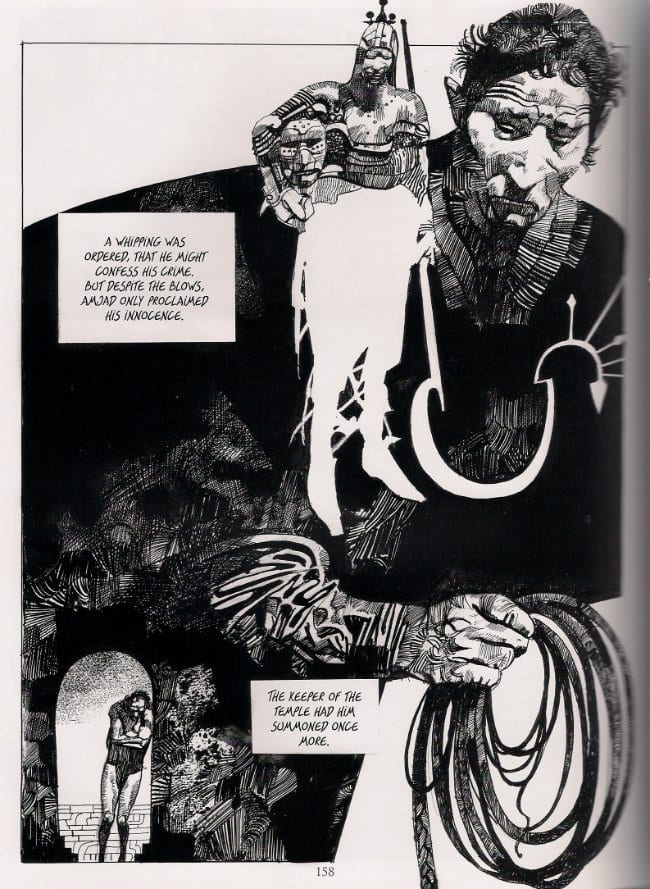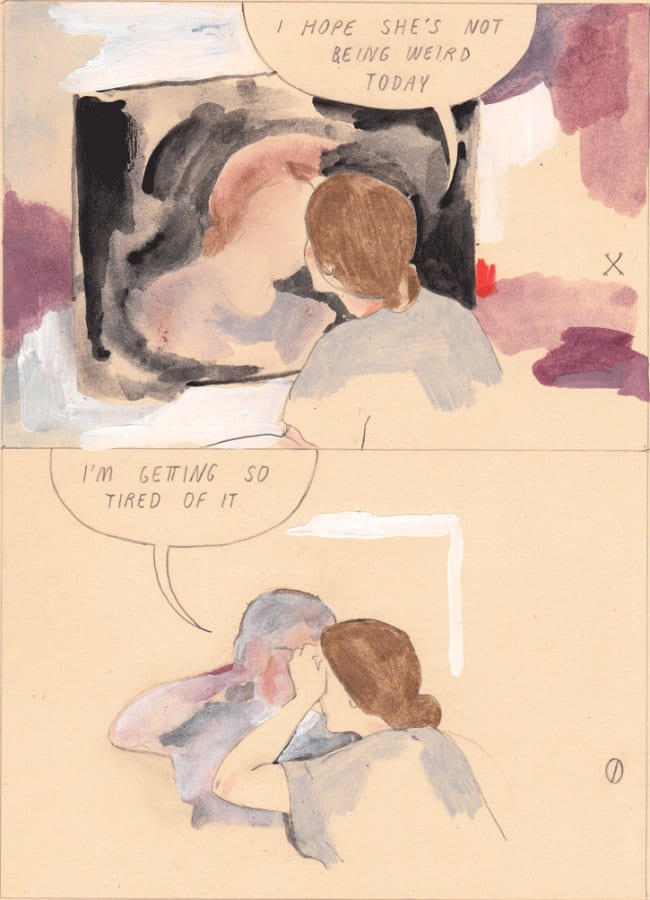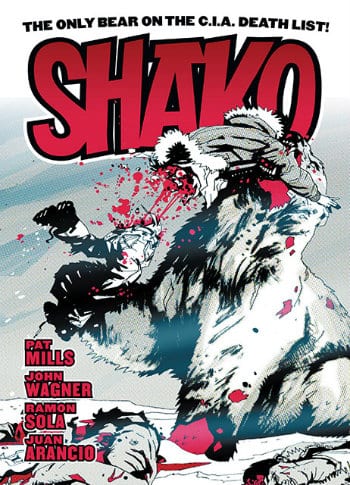I'm not doing a best-of list or anything -- I just lack the initiative -- but if I was I'd be sure to rank Aidan Koch's The Blonde Woman highly. It's a comic I've mentioned a few times, and a comic a lot of people still want to discuss - enough, apparently, for the Journal's Sean T. Collins to make note of the amount of discussion surrounding Koch's work in his interview with the artist.
But I was struck by other portions of that chat.
"I don’t feel like I’m really trying to tell stories."
and
"The Blonde Woman has a lot of little cues that I was really excited about through the jumps in time to the jumps in reality and between characters.... Although I’m interested in fully abstracted comics, I’m more intrigued in how I can use it within a narrative context or structure."
The notion of harnessing "narrative" in both a representational and abstract manner, in defiance of telling a concrete "story," is the very heart of what I take from Koch's work, although I often find it difficult to explain the character of my readings. But put simply, I respond to Koch's work -- The Blond Woman in particular -- as 'experiential comics,' which is to say a comic that deploys narrative information as a means of evoking some subjective approximation of feeling an environment, or an emotion, as opposed to depicting discreet events in a neat sequence.
For example, above we see a whoosh of yellow and a smudge of night sky; decoding Koch's "cues" from throughout the work, I can discern this is the Blonde Woman's movement, her head (hair) still full of sleep and night - a state we eventually learn she prefers. Perhaps the next panel is a point of view image of a darkened room, with a spot of black in her vision, or maybe it's an eclipsed moon imposed onto a closed nighttime space. Regardless, I can experience the Blonde Woman's navigation - critically, Koch then presents an image of feet, and then the floor, and then feet again: less a depiction of feet walking than an interruption of of the idea of "walking" with the sensation of what one is walking on. Experience.
It's a sort of meaningful collage, a capacity of the comics form. Indeed, Koch is not the first to explore such techniques, which exist in works quite far from The Blonde Woman and its conceptual aims.
Witness above a page from Archaia's new edition of the late Italian master Sergio Toppi's Sharaz-De: Tales from the Arabian Nights. We've gone from one of my favorite new comics to one of the best vintage translations of 2012, but while Toppi is typically renowned for his decorative and bravura sense of page design, I see this particular image as functioning in a not dissimilar way to Koch's image. He too presents representational images that collage into something not quite so clean as a series of captured moments.
Instead, a favorite Toppi trick is deployed up top: a city jutting up from the very head of the representative of that city, fusing place and person together. Read from left to right, top to bottom, the page is less a demonstration of how sulking Shahzam'an enters his brother's city, but a blast of the city itself, and then the brother, beaming and big, and then the diminished, sullen sillouette of the 'hero' entering from the bottom portal of an impossible stalactite building. Toppi too is using "cues," as the bird held out by his brother -- with a narrative caption detailing Our Man's sorrows literally tied to its neck! -- will appear again in a garden full of birds, where Shahzam'an will discover his brother's wife in the act of illicit love, deepening his sorrows.
Toppi, of course, is a fairly prolix narrator, while Koch avowedly considers "what is the minimum information needed to move the story along?" Here, we see a rather cinematic pull-back from a darkened window, although it's as impossible a portal as Toppi's hanging tower. Shoots of vegetation grow around it, and we enjoy an isolated image of the greenery as the Blonde Woman's telltale hair sweeps by again, accompanied by her lingering night. I find this beautifully evocative of movement, though not depictive of such; rather, the juxtaposition of images details those sensory pickups -- nature's little "cues" -- that approximate the interior and exterior stimuli of motion.
Burdened, one imagines, with more in the way of "story" expectations, Sharaz-De describes the occurrence of a whipping, though Toppi's images provide a somewhat more decompressed set of stimuli: the looming Keeper, the ironed guard, the agonized prisoner and the coiled whip. While Koch is interested in nearly second-to-second sequences broken up, without warning, by jumps in narrative time, Toppi uses individual page designs to swirl period of time into a type of summary - perhaps a recollection, as opposed to the you-are-here of The Blonde Woman. The irony there is that Koch's narrative ultimately waits to usurp chronology, while Toppi is, in the end, telling as much of an A-to-B story as his titular narrating Scheherazade.
We should, however, witness these effects over several pages. Particularly since that will allow me to post my favorite transition in the whole of The Blonde Woman.
This is hilarious; how two-faced! Maybe she sees a little too much of herself in the Blonde Woman, as Koch bumps the narrative forward in time at the moment the Brunette Woman raises her hand to the mirror, transforming it into a door like a magician performing a trick. Such sleight of hand is central to the story's mechanics.
Toppi, meanwhile, is less concerned with subtle transformations; like Moebius' nearly contemporaneous The Airtight Garage, Sharaz-De seems to function as a compendium of every manner of b&w shading, and every page aims to overwhelm.
We return to Shahzam'an and the garden of birds. He is still feeling small, smaller than his brother, though the attentive reader will note the smaller birds circling the giant impression of a bird, first black silhouettes against a white sky, then white outlines, descending to meet the similarly empty man, his reflection fizzling away in the water. He maneuvers through a portal, traversing huge, irrational clusters of foliage - no tiny Koch sprouts here. And then, at the bottom, Toppi robs him of even the dignity of directly witnessing the infidelities of the garden; he only stares off into space, an abstract thatch of hatching sculpted into a window, and below we feel the betrayal.
Portals, grass, duplicity. One comic may be a quintessentially experimental success, while the other might be half a step removed from the august pages of Creepy, but together I understand some unity of narrative techniques, storied formal characteristics redolent with unique potential.
***
PLEASE NOTE: What follows is not a series of capsule reviews but an annotated selection of items listed by Diamond Comic Distributors for release to comic book retailers in North America on the particular Wednesday, or, in the event of a holiday or occurrence necessitating the close of UPS in a manner that would impact deliveries, Thursday, identified in the column title above. Not every listed item will necessarily arrive at every comic book retailer, in that some items may be delayed and ordered quantities will vary. I have in all likelihood not read any of the comics listed below, in that they are not yet released as of the writing of this column, nor will I necessarily read or purchase every item identified; THIS WEEK IN COMICS! reflects only what I find to be potentially interesting.
***
SPOTLIGHT PICKS!
Shako: When comics readers speak of a "Silver Age," typically they are pining - for a less encumbered time, for simpler, more direct genre stuff. An ideal of 'fun' is frequently evoked, in sharp comparison to the dreary offerings of today. Crucially, many of these nostalgists did not enjoy a first-hand experience with these halcyon funnies; in this way, the past itself can be unencumbered with the niggling recollection of complicating ambiance. No, the Silver Age can be sealed - perfect fun. I'm as guilty as all the rest, but it's not *actual* Silver Age comics that form my "Silver Age"; what I prefer is the seat-of-your-pants, written-on-the-fly breakneck velocity of bleary-eyed late-'70s 2000 AD, berserk youth comics that hewed to no standard but that of sensation, which at their best seemed just barely under control.
And among the very, very best of those was 1977's Shako, about a large bear that swallows a valuable item and eventually pushes the world's superpowers to the brink of nuclear annihilation, but not before becoming a friend to children and mauling the fuck out of the corrupt adult world. Written by John Wagner, with Pat Mills (basically continuing an earlier large-creature/righteous-violence serial, the beloved Hook Jaw) and a rotating cast of period Brit comics workmen -- Ramon Sola, César López-Vera, Juan Arancio, "Dodderio" -- some of whom fully embrace the garish spirit of the feature by just drawing the hairy brute like a person lumbering across the tundra in a bear suit. There's incessant references to One Flew Over the Cuckoo's Nest and a strapping hero named Buck Dollar, but what mostly registers is a sense of rightly adolescent rage over the dim prospect of merely existing in a world dictated by the violent maneuvers of obscure politics. ANIMALS ARE AWESOME, PEOPLE SUCK! THE ONLY BEAR ON THE C.I.A. DEATH LIST! Now in hardcover, 96 pages, with a never-reprinted story from a 1978 Annual. Preview; $17.99.
The Silver Darlings: I couldn't tell you a blessed thing about this Blank Slate release of comics by UK artist Will Morris, but the style on display is keenly reminiscent of Gipi, and all those ink washes will probably serve a seafaring scenario well. A 60-page, 8" x 11.25" hardcover album - give it a flip if you spot it. Samples; $14.99.
--
PLUS!
B.P.R.D. Hell on Earth #103: Marking the return of Mr. James Harren to this series, following up his fine showing on last year's The Long Death with a two-issue story focusing on ancient secrets. Editor Scott Allie takes the place of John Arcudi, while Mike Mignola co-writes as usual. Preview; $3.50.
Sweet Tooth #40: Elsewhere, affairs come to an end. I think this Jeff Lemire solo series from Vertigo has gotten overshadowed by its creator's scriptwriting contributions to DC's superhero line, but forty issues is still a pretty sturdy run by serialized comics standards, and Lemire's in good enough a position to get an extra-long 48 pages for his grand finale; $4.99.
Cherubs!: Lazy Bryan Talbot. If he'd worked really hard, he could have had three substantial books out in 2012, but I guess he'll have to settle for the Costa Prize-winning Dotter of Her Father's Eyes (written by Mary Talbot) and the Tucker Stone Top 19-placing Grandville Bête Noire (which amusingly gets into some of the same art history rhetoric as the notorious Ian F. Svenonius intro to Kramers Ergot 8). Actually, parts of this 192-page Dark Horse hardcover appeared in an identically-titled Desperado Publishing release from 2007, but much of its no-doubt rude take on Biblical tropes has never before seen release. Note that Talbot is the writer, while Mark Stafford draws. Preview; $19.99.
Reset: Also in beloved offbeat comics veterans, Dark Horse offers a 6" x 9" hardcover collection for Peter Bagge's recent miniseries, a comedy about a man reliving life to unsettling effect. Samples; $15.99.
Flaming Carrot Comics: The Wild Shall Wild Remain!: But then, you can always go back to a yet-earlier time in alternative comics with this 256-page compilation of mid-'80s b&w anarchy from Bob Burden, specifically issues #4-11 of the Aardvark-Vanaheim and Renegade Press Flaming Carrot Comics, with an all-new short story included to sweeten the deal. Published by Bob Burden Studios, as a signed and numbered print accompaniment to a digital publication effort funded via Kickstarter; $49.95.
Gil Kane's The Amazing Spider-Man Artist's Edition: MORE DELUXE - another IDW mega-special, this time memorializing the original art to issues #96-102 and 121 of The Amazing Spider-Man over 216 pages, which includes the bits where Harry enjoys chemical pleasure and Gwen is offed. Is this the first Artist's Edition where the artist didn't provide all his own inks? It's 12" x 17", in color (but not 'colored'); $125.00.
The Black Incal: ALSO DELUXE, BUT IN A DIFFERENT WAY - Kim Thompson observed last week that Humanoids' most recent omnibus printing of The Incal appears to have already cleared itself out of Amazon. Hopefully more will be available soon, since it's gonna be a while for the whole series to come out in this new, most-lavish-ever format, reprinting the original series album-by-album at 12" x 16". That's 48 pages of Moebius & Jodorowsky here, in the original Yves Chaland colors, hailing from 1981. Les Humanoïdes in France is presently flogging a similar edition of The Airtight Garage (with its own box!), for the import-minded among you. Samples; $79.95.
Alex Toth's Zorro: The Complete Dell Comics Adventures: Sooo many reprints this week, and I think this batch of Toth's admired Dell work has actually gotten an all-in-one edition before, albeit in b&w a decade or so back from Image. This is a new 7.5" x 10" Hermes Press hardcover, 240 pages in the original color; $49.99.
Comics About Cartoonists: Finally, Craig Yoe and IDW serve up 192 pages of... funnies about draw-ers. Work by Charles Schulz, George Herriman, Winsor McCay, E.C. Segar, Steve Ditko, Harvey Kurtzman, Jack Kirby, Chester Gould, Jack Cole, Basil Wolverton, Milton Caniff, Ernie Bushmiller, Will Eisner, Jerry Siegel & Joe Shuster, Dick Briefer and others is promised. An 8.5" x 11" hardcover; $39.99.
--
CONFLICT OF INTEREST RESERVOIR: Terror of the present, as Tom Kaczynski collects his excellent short stories of uneasy habitation into Beta Testing the Apocalypse, a 136-page softcover boasting substantial a new piece; $19.99. Struggles of the past, as Texas history returns to print in Jack Jackson's American History Vol. 1: Los Tejanos & Lost Cause, the 320-page first of three hardcover volumes set to collect the entirety of the underground pioneer's nonfiction graphic novels; $35.00.
















